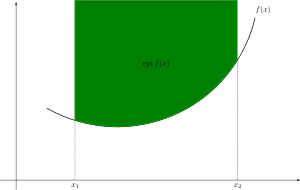Epigraph (mathematics)

In mathematics, the epigraph or supergraph[1] of a function f : Rn→R is the set of points lying on or above its graph:
The strict epigraph is the epigraph with the graph itself removed:
The same definitions are valid for a function that takes values in R ∪ ∞. In this case, the epigraph is empty if and only if f is identically equal to infinity.
The domain (rather than the co-domain) of the function is not particularly important for this definition; it can be any linear space[1] or even an arbitrary set[2] instead of .
Similarly, the set of points on or below the function is its hypograph.
The epigraph can often be used to give geometrical intrepretations of the properties of convex functions or to prove these properties.
Properties
A function is convex if and only if its epigraph is a convex set. The epigraph of a real affine function g : Rn→R is a halfspace in Rn+1.
A function is lower semicontinuous if and only if its epigraph is closed.
References
- 1 2 Pekka Neittaanmäki; Sergey R. Repin (2004). Reliable Methods for Computer Simulation: Error Control and Posteriori Estimates. Elsevier. p. 81. ISBN 978-0-08-054050-4.
- ↑ Charalambos D. Aliprantis; Kim C. Border (2007). Infinite Dimensional Analysis: A Hitchhiker's Guide (3rd ed.). Springer Science & Business Media. p. 8. ISBN 978-3-540-32696-0.
- Rockafellar, Ralph Tyrell (1996), Convex Analysis, Princeton University Press, Princeton, NJ. ISBN 0-691-01586-4.